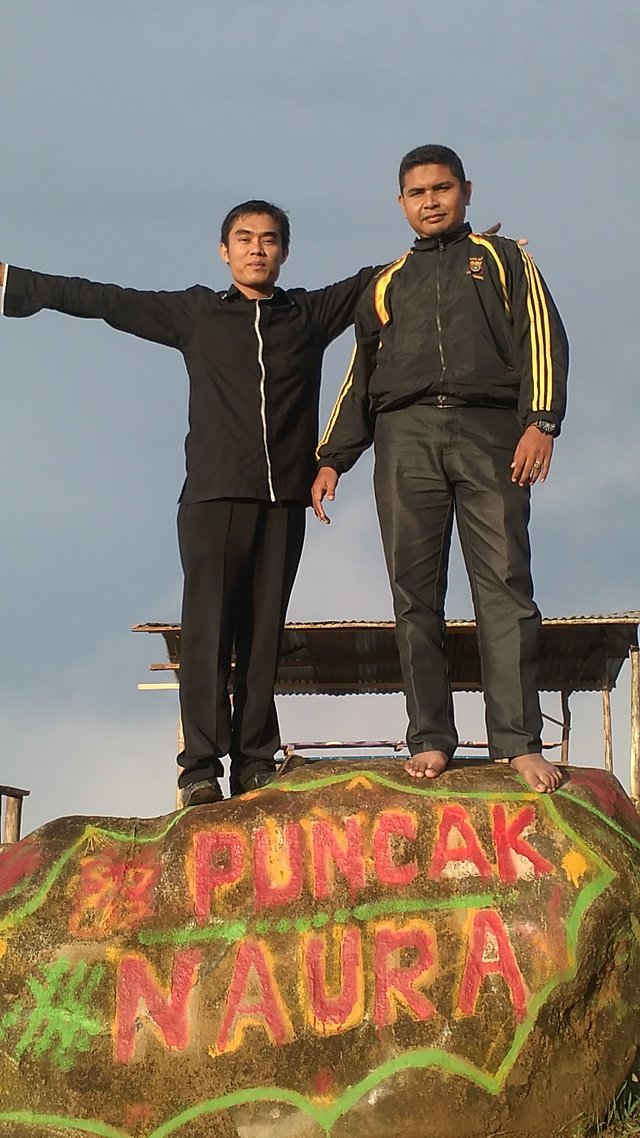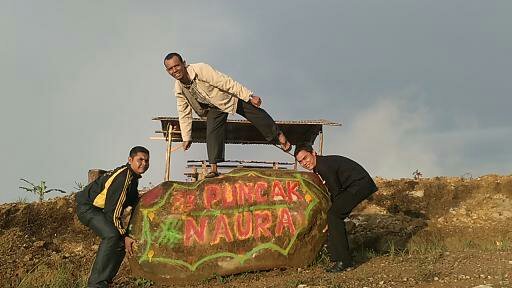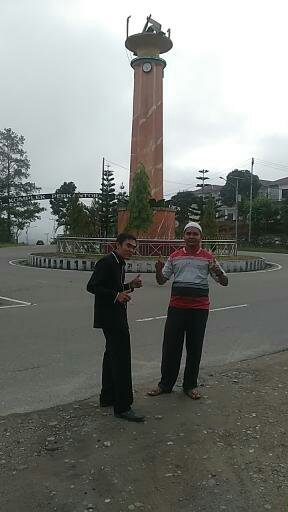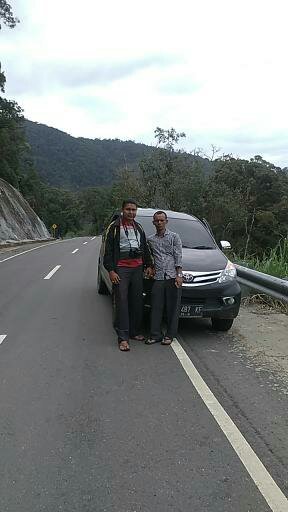Gayo Lues at the time of the Kingdom of Aceh
Hello Guys ,,, introduce me with my best friend who is traveling so that it takes up to three days and three nights to go to Gayo Lues from Lhokseumawe City ...


We try to lift this big stone as a form of our responsibility as friends. But our strength is inadequate, meaning we still need more friends in trying to lift this great burden.

This is the office of the Gayo Lues regent that we visited in this case I and with my friends want to tell about the history of Gayo Lues.
During the reign of Sultan Iskandar Muda the Gayo and Alas regions were officially included in the Kingdom of Aceh. Gayo and Alas are divided into several regions called Kejurun. Kejurun is given a bawar, sword (a kind of command stick) in lieu of a decree.
The Gayo and Alas regions are divided into eight Kejurun (Vocational, Gayo.Red), six in Gayo and two in Tanah Alas. In Gayo, namely Bukit Vocational School, Linge, Syiah Utama, Patiambang, Bebesen and Abuk. In Tanah Alas, Batu Mbulan and Bambel. Vocational Patiambang is based in Penampakan, with an area of all Gayo Lues with 55 villages.
The head of government is held by the Vocational School with the help of 4 Reje people, namely Reje Gele, Bukit, Rema and Kemala, and eight Reje Cik, namely: Porang, Kutelintang, Tampeng, Kemala Derna, Peparik, Penosan, Gegarang and Padang. The main task of Reje and REje Cik is to develop their respective regions and collect taxes from the people and choose Vocational. Vocationally every year deposit tribute to the Sultan of Aceh.
Van Daalen expedition to the Gayo Lues area
After the Sultan of Aceh Muhammad Daudsyah surrendered to the Dutch in 1903, then the Aceh Military Governor Van Heutsz decided to conquer the whole of Aceh. Areas that have not been subdued are Gayo Lues and Alas Van Heutsz ordered Van Daalen to conquer the two regions.
After everything was considered complete, Van Daalen began attacking the Gayo Lues area in 1904. After defeating Gayo Laut, Gayo Deret, Van Daalen finally entered the Gayo Lues area in a remote village, Kampung Kela (March 9, 1904). From here the Gayo Lues area was conquered by fortresses for the sake of the fortress.
Starting with conquering Benteng Pasir (March 16, 1904), Gemuyung (18,19,20 March 1904), Durin (March 22, 1904), Rhino (April 4, 1904), Occult Rikit (April 21, 1904), Penosan (May 11, 1904) , Tampeng (May 18, 1904). Almost all the contents of the fort were destroyed and the wounded were finally killed. according to Keempes and Zentegraaf (Dutch Author) almost 4,000 Gayo and Alas people died, including Gayo fighters such as Aman Linting, Aman Jata, H. Sulaiman, Lebe Jogam, Srikandi Inen, Tri, Dimus and others.
Gayo Lues in the Dutch colonial era
Dutch troops who left Gayo Lues to Alas Land returned in 1905 to form the Government. For Gayoo and Alas formed a Civil Administration called Onder Afdeling (Kabupaten). Onder Afdeling Gayo Lues oversees three areas called Landschap (Kecamatan), namely:
Landschaap Gayo Lues in Blang Kejeren is headed by Aman Safii
Landschaap Batu Mbulan is headed by Berakan
Landschaap Bambel is headed by Shahiddin
From 1905-1942 Alas Land was subject to Gayo Lues. In 1926 there was a popular uprising against the Dutch in Blang Kejeren led by Muhammad Din, the rebellion failed, it was extinguished and Muhammad Din was banished to Boven Digul (Irian) while his friends were banished to Cilacap, Sukamiskin and Madura.

Gayo Lues in the Japanese colonial era
In 1942-1945 Gayo Lues was made Japan as Japan's last defense area. This area is suitable for military concentration. For this reason, the Gayo Lues youth were trained in military affairs in the amount that these young men expected to become supporters of the Japanese military. The young men from the Japanese military training included Muhammad Din, Bahrin, Zakaria, Maaris, Maat, Jalim Umar, Abdurrahim, Asa, Dersat, Hasan Sulaiman, Ahmad Aman Bedus, Hasan Tejem and others who later served in aggression I and II.
Gayo Lues during the Independence of the Republic of Indonesia
The old Gema Proklamasi arrived at Gayo Lues. The certainty was only obtained at the end of September 1945. On October 4, 1945 the text of the Proclamation was read again in Blangkejeren by Muhammad Din. At the year 1946 the Government of Aceh established the inland area to be a district (Keluhakan) called Keluhakan Aceh Tengah.
Luhak (Regent) and the district capital were discussed between the leaders of Takengon, Blang Kejeren and Kutacane. After the election of King Abdul Wahab was held as Luhak Aceh Tengah while Takengon was chosen as the capital, A.R. He became a Trainer, Mude was becoming Wedena Takengon, M. Saleh Aman Sari became the Wedana Gayo Lues and Khabar Ginting became the Wedana Tanah Alas.
After the formation of the Government was formed and it began for several months, it was difficult to run the government because the Takengon-Blang Kejeren-Kutacae relationship was very far away. On the basis of the above difficulties Gayo and Alas struggled to form their own regencies since 1957. After going through a struggle full of twists and turns, finally in 1974 Gayo and Alas were formed into a Regency called Southeast Aceh Regency with Act No. 4 of 1974 dated June 26, 1974.
The formation of the Gayo Lues Regency
With the enactment of Law No. 5 of 1974, the status of the Kewedanaan is replaced by the term Regent. However, since 1975, 1981 the status of Gayo Lues was still in a transitional status because Gayo Lues was made the Government's coordinating area for 4 Sub-districts. It was not until 1982 that Gayo Lues Funding was made into the Assistant Area of the Gayo Lues Regent, led by the Regent's Assistant.

Due to the limited authority added to the extent of the area that must be coordinated and also the lack of Southeast Aceh PAD there is an impression that the development progress of Gayo Lues was deactivated; four intersections, namely: Blang Kejeren - Takengon; Blang Kejeren - Aceh Selatan; Blang Kejeren Kutacane and Blang Kejeren - East Aceh.
This has triggered the acceleration of the economic growth of the Gayo Lues region which supports PMDN and PMDA to invest. The internal factors above are supplemented by external factors by the inauguration of the Simeulu Regent Assistant to the Administrative District, following the Assistant of the Regent of Bireuen and the Assistant of the Singkil District Head. This is what stimulates the gayo Lues community to follow in the footsteps of the area above.
Upvoted.
@muh-isa, I gave you a vote!
If you follow me, I will also follow you in return!
Thanks best friends